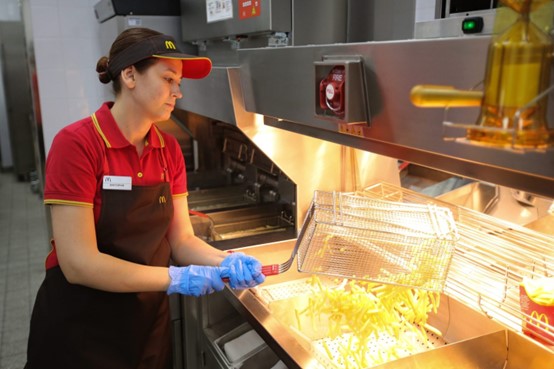
事实证明,快餐消费者并不想要薯条。随着越来越多顾客因为高昂的价格对快餐失去了兴趣,北美最大的薯条生产商因为市场放缓而陷入困境。
蓝威斯顿(Lamb Weston)仅一家工厂每年生产的冷冻土豆制品就高达2.5亿磅。本月早些时候,该公司宣布将裁员4%(约428名工人),并关闭位于华盛顿州康奈尔的工厂。自今年年初以来,该公司的股价已暴跌约33%。
蓝威斯顿的发言人对《财富》杂志表示,此次关闭的是一家较为老旧的工厂,仅占公司产能的5%。
蓝威斯顿CEO汤姆·沃纳在10月1日的业绩电话会议上表示,快餐汉堡连锁餐厅是导致公司业绩下滑的罪魁祸首。在蓝威斯顿的第一季度,这些餐厅的客流量下降了3%,客流量同比整体下滑了2%。沃纳预计,2025财年,客流量将继续下滑。
麦当劳(McDonald’s)是蓝威斯顿的最大客户,贡献了公司13%的销售额。这家土豆加工公司还为百胜餐饮集团(Yum Brands)(旗下有肯德基(KFC)和塔可钟(Taco Bell)等品牌)生产薯条。
菜单价格上涨使得快餐对于许多消费者来说变成了奢侈品,这意味着麦当劳和温迪快餐厅(Wendy’s)等行业巨头难以吸引消费者,更不用说让人们大手大脚地消费。上个季度,麦当劳的同店销售额下降了1%,而百胜餐饮第二季度的收入同比上涨了4.5%,但由于销售令人失望,因此未能达到预期。
麦当劳美国总裁乔·厄林格7月份对投资者表示:“归根结底,我们预计在竞争高度激烈的大环境下,至少在未来几个季度,消费者将继续感受到经济和生活成本上升带来的压力。”
炸薯条作为经济指标
沃纳认为,薯条销售情况通常是体现经济健康状况的良好指标。薯条通常是快餐中消费最多的配菜之一,当消费者感到手头拮据时,往往会取消薯条。但在经济状况良好时,薯条是顾客首先会添加到订单中的配菜。沃纳在去年十月接受CNBC采访时,将这种情况称之为“薯条加购率”。
尽管在2022年,薯条加购率实际上从疫情之前的22%提高到24%,但在快餐行业适应艰难环境的过程中,蓝威斯顿仍在苦苦挣扎。麦当劳CEO克里斯·坎普钦斯基在2月份承认,越来越多的消费者为了节省开支,选择在家做饭。这不仅对麦当劳来说是个坏消息,对蓝威斯顿也是个麻烦,因为该公司表示,美国消费的所有冷冻薯条产品中有80%来自快餐厅。
快餐行业的增速放缓还引发了价值战,快餐厅推出了促销套餐以吸引顾客回流,包括麦当劳的5美元套餐和温迪的3美元双人早餐套餐。但是,尽管这些促销措施帮助增加了店内客流量,却对蓝威斯顿帮助不大,因为餐厅顾客并不热衷于升级到更大份的薯条。
沃纳表示:“值得注意的是,许多这些促销套餐让消费者将薯条从中份换成了小份。”
然而,对蓝威斯顿来说还有一线希望。沃纳表示,除了在困难时期维持与餐厅的合作外,该公司在上个季度还扩大了与其他连锁店的业务。
哥伦比亚商学院(Columbia Business School)的食品和餐厅顾问斯蒂芬·扎戈尔表示,至少对于麦当劳来说,特别是随着通胀的降温,快餐业的放缓将是短暂的。
他在7月份对《财富》杂志表示:“这将是短暂的波动。消费者终将回归。他们总是会恢复快餐消费。”
麦当劳和百胜餐饮均未回应《财富》杂志的置评请求。(财富中文网)
译者:刘进龙
审校:汪皓
事实证明,快餐消费者并不想要薯条。随着越来越多顾客因为高昂的价格对快餐失去了兴趣,北美最大的薯条生产商因为市场放缓而陷入困境。
蓝威斯顿(Lamb Weston)仅一家工厂每年生产的冷冻土豆制品就高达2.5亿磅。本月早些时候,该公司宣布将裁员4%(约428名工人),并关闭位于华盛顿州康奈尔的工厂。自今年年初以来,该公司的股价已暴跌约33%。
蓝威斯顿的发言人对《财富》杂志表示,此次关闭的是一家较为老旧的工厂,仅占公司产能的5%。
蓝威斯顿CEO汤姆·沃纳在10月1日的业绩电话会议上表示,快餐汉堡连锁餐厅是导致公司业绩下滑的罪魁祸首。在蓝威斯顿的第一季度,这些餐厅的客流量下降了3%,客流量同比整体下滑了2%。沃纳预计,2025财年,客流量将继续下滑。
麦当劳(McDonald’s)是蓝威斯顿的最大客户,贡献了公司13%的销售额。这家土豆加工公司还为百胜餐饮集团(Yum Brands)(旗下有肯德基(KFC)和塔可钟(Taco Bell)等品牌)生产薯条。
菜单价格上涨使得快餐对于许多消费者来说变成了奢侈品,这意味着麦当劳和温迪快餐厅(Wendy’s)等行业巨头难以吸引消费者,更不用说让人们大手大脚地消费。上个季度,麦当劳的同店销售额下降了1%,而百胜餐饮第二季度的收入同比上涨了4.5%,但由于销售令人失望,因此未能达到预期。
麦当劳美国总裁乔·厄林格7月份对投资者表示:“归根结底,我们预计在竞争高度激烈的大环境下,至少在未来几个季度,消费者将继续感受到经济和生活成本上升带来的压力。”
炸薯条作为经济指标
沃纳认为,薯条销售情况通常是体现经济健康状况的良好指标。薯条通常是快餐中消费最多的配菜之一,当消费者感到手头拮据时,往往会取消薯条。但在经济状况良好时,薯条是顾客首先会添加到订单中的配菜。沃纳在去年十月接受CNBC采访时,将这种情况称之为“薯条加购率”。
尽管在2022年,薯条加购率实际上从疫情之前的22%提高到24%,但在快餐行业适应艰难环境的过程中,蓝威斯顿仍在苦苦挣扎。麦当劳CEO克里斯·坎普钦斯基在2月份承认,越来越多的消费者为了节省开支,选择在家做饭。这不仅对麦当劳来说是个坏消息,对蓝威斯顿也是个麻烦,因为该公司表示,美国消费的所有冷冻薯条产品中有80%来自快餐厅。
快餐行业的增速放缓还引发了价值战,快餐厅推出了促销套餐以吸引顾客回流,包括麦当劳的5美元套餐和温迪的3美元双人早餐套餐。但是,尽管这些促销措施帮助增加了店内客流量,却对蓝威斯顿帮助不大,因为餐厅顾客并不热衷于升级到更大份的薯条。
沃纳表示:“值得注意的是,许多这些促销套餐让消费者将薯条从中份换成了小份。”
然而,对蓝威斯顿来说还有一线希望。沃纳表示,除了在困难时期维持与餐厅的合作外,该公司在上个季度还扩大了与其他连锁店的业务。
哥伦比亚商学院(Columbia Business School)的食品和餐厅顾问斯蒂芬·扎戈尔表示,至少对于麦当劳来说,特别是随着通胀的降温,快餐业的放缓将是短暂的。
他在7月份对《财富》杂志表示:“这将是短暂的波动。消费者终将回归。他们总是会恢复快餐消费。”
麦当劳和百胜餐饮均未回应《财富》杂志的置评请求。(财富中文网)
译者:刘进龙
审校:汪皓
It turns out that, no, fast-food eaters would not like fries with that. As more customers lose their appetite for fast food over sky-high prices, North America’s largest fry producer is reeling from the slowdown.
Lamb Weston, which can churn out 250 million pounds of frozen potato products annually at just one facility, announced earlier this month that it would lay off 4% of its workforce (about 428 workers) and shut down its Connell, Wash., production plant. Since the beginning of the year, its share price has plummeted by about 33%.
A Lamb Weston spokesperson told Fortune the closed plant was an older facility representing only 5% of the company’s capacity.
CEO Tom Werner said on an Oct. 1 earnings call that quick-service burger chains in particular are to blame for Lamb Weston’s slump. Traffic at those restaurants decreased 3% in the company’s first quarter, while restaurant traffic overall slumped 2% year over-year. Werner expects traffic to continue to falter through fiscal 2025.
McDonald’s is Lamb Weston’s largest customer, accounting for 13% of its sales. The potato processor also produces fries for Yum Brands, which owns KFC and Taco Bell.
Menu price inflation has turned fast food into a luxury for many consumers, meaning industry titans like McDonald’s and Wendy’s have struggled to attract consumers, let alone get them to splurge. McDonald’s same-store sales shrank 1% last quarter, and while Yum Brands reported a 4.5% bump in year-over-year revenue for its second quarter, it fell short of expectations due to disappointing sales.
“At the end of the day, we expect customers will continue to feel the pinch of the economy and a higher cost of living for at least the next several quarters in this very competitive landscape,” McDonald’s U.S. President Joe Erlinger told investors in July.
French fries as an economic indicator
Werner argues that french fry sales are generally a good indicator of economic health. They are usually one of the more expendable fast-food side items and are nixed from orders when consumers feel penny-pinched. But during healthy economic times, they’re the first side that customers add to their order. Werner called this the “fry attachment rate” in a CNBC interview last October.
Despite the fry attachment rate actually increasing to 24% in 2022, compared to 22% before the pandemic, Lamb Weston has continued to struggle as the fast-food industry adapts to a difficult environment. McDonald’s CEO Chris Kempczinski acknowledged in February more consumers are turning to home-cooked meals to save money. Beyond that being bad news for McDonald’s, it’s also trouble for Lamb Weston, which said that 80% of all frozen fries products consumed in the U.S. comes from fast-food restaurants.
The fast-food industry slowdown has also sparked a value war and the introduction of promotional meal deals to lure back customers, including the McDonald’s $5 meal deal and the Wendy’s two-for-$3 breakfast deal. But while such enticements have helped increase store traffic, the promotions haven’t been of much help to Lamb Weston, as restaurant visitors aren’t eager to upgrade to larger fry sizes.
“It’s important to note that many of these promotional meal deals have consumers trading down from a medium fry to a small fry,” Werner said.
There’s a silver lining for Lamb Weston, however. Werner said that in addition to maintaining its restaurant partners during the difficult stretch, the company also expanded business with other chains this past quarter.
Stephen Zagor, a food and restaurant consultant who teaches at Columbia Business School, said the fast-food slowdown, at least for McDonald’s, will be short-lived, particularly as inflation cools.
“It’s going to be a blip,” he told Fortune in July. “They’re going to come back. They always come back.”
McDonald’s and Yum Brands did not respond to Fortune’s request for comment.






